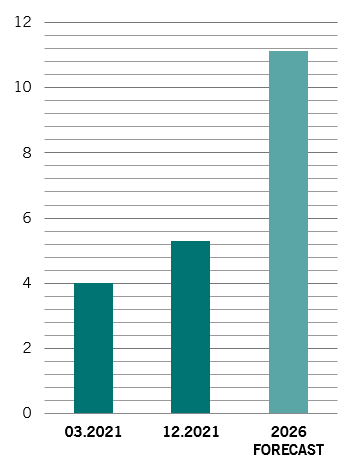Why co-investment is an attractive alternative to traditional private equity vehicles.
David Maréchal, Deputy Head of PE & Co-Head of Europe Pictet Asset Management.
Private equity (PE) markets are booming. Global PE assets under management have reached USD5.3 trillion and, according to Preqin, are on track to more than double to USD11.1 trillion by 2026. To its advocates, PE offers the prospect of higher returns and diversification benefits. Its detractors, meanwhile, point out that this comes at a price: high fees, low transparency and long delays before money is deployed and investments start to make a profit.
However, there is one area of PE where those factors don’t weigh as heavily: co-investments. Through this structure, private equity funds (known as general partners, or GPs) offer select investors (limited partners, LPs) the opportunity to invest directly alongside them in a specific transaction.
In the past two decades, co-investment funds have raised over USD175 billion. Yet PE continues to expand, and we expect co-investments to grow too.
Fig. 1 - Investment boom
Global private equity AUM (USD tn)

Source: Preqin, "Global private equity and venture capital report 2022".
For GPs, the main benefit of co-investment is the ability to invest more in firms they consider attractive. (GPs are often subject to concentration restrictions, limiting how much capital they themselves can invest in a single company).
For LPs, one of the key advantages of co-investing is direct access to high quality private companies. Rather than investing in hundreds of firms through a fund-of-funds vehicle, a co-investment strategy is much more focused (typically in 25-30 companies) while retaining adequate diversification across GPs, countries and industries.
Another benefit is the fact that co-investments are deployed much more rapidly (usually over two to three years) than traditional PE funds of funds, which can take six to seven years to reach full investment. Earlier deployment can help mitigate the problem embodied by the J-curve, or the tendency for PE investments to deliver capital losses in the early years of their life before generating gains. This is borne out by our own 30 years’ experience of co-investing at Pictet.
Ultimately, the net return is boosted by the fact that GPs typically offer co-investments free of the usual management (1.5-2.0 per cent) and performance fees (20 per cent). This is significant in an asset class known for its high fees.
However, attractive co-investment opportunities are not always easy to access. GPs tend to only offer deals to their most trusted partners. LPs, meanwhile, need a lot of experience and expertise to assess the deals offered and carry out due diligence. For most investors, this route is effectively closed. Unless, of course, they opt for a co-investment fund.
Co-investment funds are run by managers that have close relationships with GPs and use this to source deals which they thoroughly vet with the help of sector specialists before including the best ones in a co-investment portfolio for clients. The end investors can thus access choice investments at reduced overall fees and with shorter deployment times relative to a PE fund of funds.
Select opportunities
It’s clearly a bottom-up, opportunistic approach, but the wealth of opportunities aids portfolio diversification across regions and sectors. Geographically, the most attractive opportunities can be found in North America, Europe and – to a lesser but growing extent – Asia, particularly China while the industries which offer the greatest potential are, in our view, services, consumer, healthcare and tech.
Our preference is for asset light companies, which are more nimble and agile than firms that require high levels of capital expenditure. Selecting market leading companies that enjoy pricing power is also an important consideration, particularly in the current environment of increased inflation.
It’s also important to diversify across different types of PE strategies, balancing out less risky buyout deals (mature companies with positive cash flows, often leaders in their fields) with some growth and venture investments (which target newer companies, whose products are not yet proven).
All in, we believe co-investment represents an attractive, opportunistic add-on to a diversified portfolio, alongside other private equity investments.



